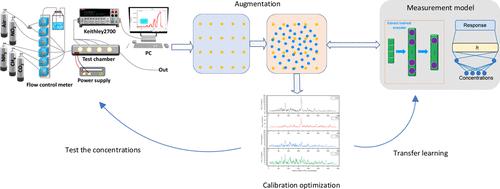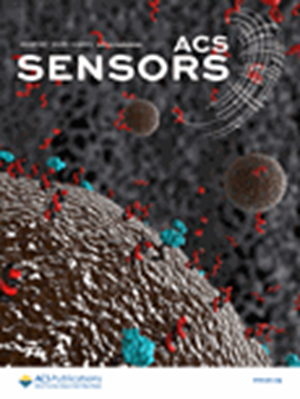一种新颖的气体传感器阵列校准方案,用于建立更精确的混合气体测量模型
IF 8.2
1区 化学
Q1 CHEMISTRY, ANALYTICAL
引用次数: 0
摘要
气体传感器阵列(GSA)通常会遇到混合气体交叉污染的挑战,导致测量混合气体的精度降低。然而,随着人工智能的出现,有效解决这一问题的途径大有可为。为了实现更精确的混合气体测量,我们提出了一种利用神经网络的测量模型。我们的方法包括利用自动编码器网络(AEN)的编码器从实验数据中提取特征,同时利用全连接层预测混合气体的浓度。为了完善神经网络参数,我们采用了变异自动编码器来生成与实验数据分布相似的额外数据。随后,我们设计了一种域差最大熵技术,以确定校准数据的最佳浓度点。这些校准点有助于训练全连接层,提高模型的准确性。在实际使用过程中,在 AEN 配置固定的情况下,可以通过在大规模 GSA 部署中使用一小部分测试点对模型进行微调。仿真和实际测量结果表明,我们提出的测量模型具有很高的准确性,在 95% 的置信水平下,四种气体测量的相对误差置信区间低于 3%。此外,与传统方法相比,校准方案减少了测试点数量,降低了人力和设备成本。本文章由计算机程序翻译,如有差异,请以英文原文为准。

A Novel Calibration Scheme of Gas Sensor Array for a More Accurate Measurement Model of Mixed Gases
Gas sensor arrays (GSAs) usually encounter challenges due to the cross-contamination of mixed gases, leading to reduced accuracy in measuring gas mixtures. However, with the advent of artificial intelligence, there is a promising avenue for addressing this issue effectively. In pursuit of more accurate mixed gas measurements, we proposed a measurement model leveraging neural networks. Our approach involved employing the encoder of an autoencoder network (AEN) to extract features from experimental data, while fully connected layers were utilized for predicting concentrations of mixed gases. To refine the neural network parameters, we employed a variational autoencoder to generate additional data resembling the distribution of experimental data. Subsequently, we designed a domain difference maximum entropy technique to identify optimal concentration points for the calibration data. These calibration points were instrumental in training the fully connected layers, enhancing the model’s accuracy. During practical usage, with the AEN configuration fixed, the model can be fine-tuned by using a small subset of test points across large-scale GSA deployments. Simulation and practical measurement results demonstrated the efficacy of our proposed measurement model, boasting high accuracy, with confidence intervals for relative errors of the four gas measurements below 3% at the 95% confidence level. Besides, the calibration scheme reduced the number of test points compared with traditional methods, reducing the cost of labor and equipment.
求助全文
通过发布文献求助,成功后即可免费获取论文全文。
去求助
来源期刊

ACS Sensors
Chemical Engineering-Bioengineering
CiteScore
14.50
自引率
3.40%
发文量
372
期刊介绍:
ACS Sensors is a peer-reviewed research journal that focuses on the dissemination of new and original knowledge in the field of sensor science, particularly those that selectively sense chemical or biological species or processes. The journal covers a broad range of topics, including but not limited to biosensors, chemical sensors, gas sensors, intracellular sensors, single molecule sensors, cell chips, and microfluidic devices. It aims to publish articles that address conceptual advances in sensing technology applicable to various types of analytes or application papers that report on the use of existing sensing concepts in new ways or for new analytes.
 求助内容:
求助内容: 应助结果提醒方式:
应助结果提醒方式:


